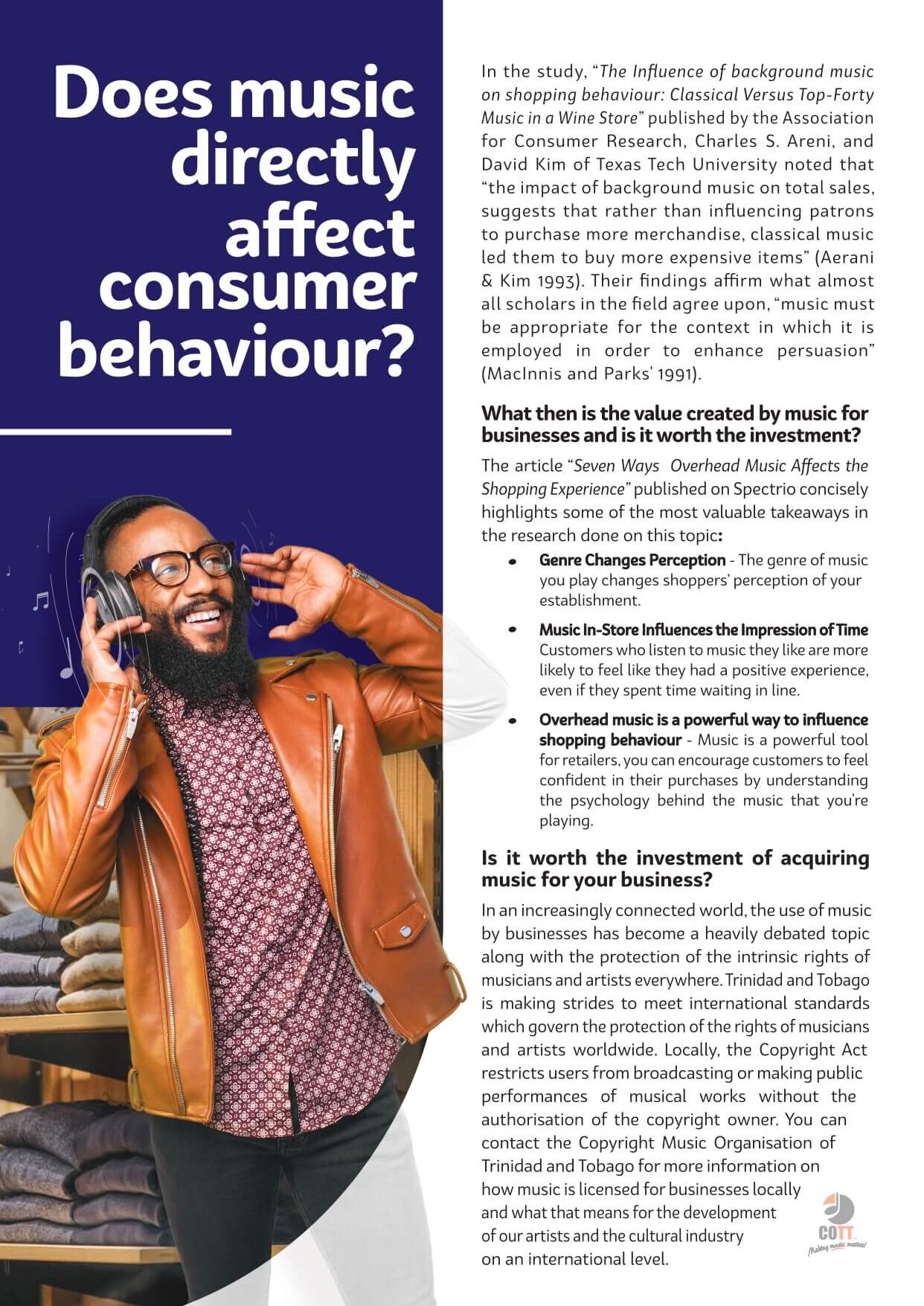Broadcast Licences Form
To ensure compliance with copyright regulations, licensed television, radio, cable, and satellite broadcasters require a Broadcast “blanket” Licence. This license enables the broadcast of numerous musical works without the need for separate clearances.
If you are involved in broadcasting or producing content that incorporates music from COTT’s repertoire and is the holder of a Concessionaire Licence from the Telecommunications Authority of Trinidad and Tobago (TATT), it is essential for you to obtain a COTT Broadcast Licence.
RADIO BROADCAST LICENCE
GENERAL TERMS AND THEIR MEANINGS
Broadcast Platform: broadcast platform is a tool that allows you to transmit your content to a large audience.
- Terrestrial – radio signals that are transmitted over land-based infrastructure, such as towers and antennas.
- Digital – audio signals that are transmitted in a digital format.
Commercial Radio: means radio stations that generate revenue through advertising. These stations are privately owned and operated, relying on advertisers to purchase airtime to generate revenue.
Commercial radio stations typically offer a diverse range of programming, including music, news, talk shows, and sports, with advertising intervals strategically placed between segments.
Gross Annual Revenue: means the total amount of income generated by the radio broadcaster or its agents in a calendar year. This includes all revenue streams, such as advertising (including barter and contra deals, product or service placement), sponsorship revenue, donations, and any other revenue related to the broadcasters’ program materials.
The revenue is calculated before deducting agency commissions or any other deductions.
Music Content: means the overall percentage of time during which musical compositions are broadcasted in comparison to
the total cumulative time that the broadcaster transmits in a given calendar year.
Net Annual revenue: means 85% of Gross Annual revenue.
Simulcast: means the simultaneous transmission of a licensed station’s broadcast through a network, in conjunction with its traditional terrestrial radio service. The simulcast is hosted by the licensee on data servers owned or controlled by the licensee.
Test Transmissions: are signals transmitted by radio stations to ascertain and confirm the proper functioning of their equipment. These tests encompass:
- Verification of transmitter power and signal strength to ensure the radio station’s signal effectively reaches its designated coverage area.
- Evaluation of audio quality to detect any concerns related to sound clarity or distortion.
- Examination of signal propagation to assess the signal’s performance across varying terrains and weather conditions.
- Confirmation of Emergency Broadcast System (EBS) functionality to guarantee its reliability during emergency situations.
These tests are typically brief, and no revenue is generated during this period
TELEVISION BROADCAST LICENCE
GENERAL TERMS AND THEIR MEANINGS
Broadcast Platform: broadcast platform is a tool that allows you to transmit your content to a large audience.
- Terrestrial – audio/ audio visual signals that are transmitted over land-based infrastructure, such as towers and antennas.
- Digital – audio/ audio visual signals that are transmitted in a digital format.
- Broadcasting via Cable or Satellite providers – audio/ audio visual signals can only be accessed via Subscription TV providers
Commercial Television: means television stations that generate revenue through advertising. These stations are privately owned and operated, relying on advertisers to purchase airtime to generate revenue.
Commercial television stations typically offer a diverse range of programming, including music videos, news, talk shows, and movies, with advertising intervals strategically placed between segments.
Gross Annual Revenue: means the total amount of income generated by the broadcaster or its agents in a calendar year. This includes all revenue streams, such as advertising (including barter and contra deals, product or service placement), sponsorship revenue, donations, and any other revenue related to the broadcasters’ program materials.
The revenue is calculated before deducting agency commissions or any other deductions.
Music Content: means the overall percentage of time during
which musical compositions are broadcasted in comparison to the total cumulative time that the broadcaster transmits in a given calendar year.
Simulcast: means the simultaneous transmission of a licensed station’s broadcast through a digital network, in conjunction with its traditional terrestrial service. The simulcast is hosted by the broadcaster on data servers owned or controlled by the broadcaster.
Test Transmissions: are signals transmitted by stations to ascertain and confirm the proper functioning of their equipment. These tests encompass:
Verification of transmitter power and signal strength to ensure the station’s signal effectively reaches its designated coverage area.
Evaluation of audio / audio visual quality to detect any concerns related to clarity or distortion.
Examination of signal propagation to assess the signal’s performance across varying terrains and weather conditions.
Confirmation of Emergency Broadcast System (EBS) functionality to guarantee its reliability during emergency situations.
These tests are typically brief, and no revenue is generated during this period.
CABLE & SATELLITE BROADCAST LICENCE
GENERAL TERMS AND THEIR MEANINGS
Commercial Cable and Satellite means cable and satellite stations that generate revenue through advertising and subscriptions. These stations are privately owned and typically offer a diverse range of programming, including music channels, news, talk shows, and sports, with advertising intervals strategically placed between segments.
Gross Annual Revenue means the aggregate of the gross valuable consideration (before deduction of agency commissions or any other deductions) whether in money or money’s worth derived and received (or receivable) by the Licensee or its agents in any calendar year including, but not limited to, subscription (including pay-per-view), advertising (including barter and contra deals and product or service placement) and sponsorship revenue and donations, and all other revenue related to a Licensee’s programme material.
Music Content means the overall percentage of time during which musical compositions are broadcast in comparison to the total cumulative time that the broadcaster transmits in a given calendar year.
Multi-channel provider means a cable/satellite operator that transmits or authorises the transmission of COTT’s Repertoire to the public via cable, linear high-speed internet protocol-based networks (encompassing broadband networks), and linear digital subscriber line technology, offering viewers a selection of multiple channels.
Simulcast means the simultaneous transmission of a licensed station’s broadcast through a network, in conjunction with its traditional terrestrial radio service. The simulcast is hosted
by the licensee on data servers owned or controlled by the licensee.
A single-channel provider is a cable or satellite operator that transmits or authorises the transmission of COTT’s Repertoire to the public via cable, linear high-speed internet protocol-based networks (including broadband networks), and linear digital subscriber line technology, through a single channel.
Subscriber means an individual or other entity entitled by agreement with the Service Provider to receive any of the Provider’s services;
Test Transmissions are signals transmitted by radio stations to ascertain and confirm the proper functioning of their equipment. These tests encompass:
Verification of transmitter power and signal strength to ensure the signal effectively reaches its designated coverage area.
Evaluation of audio / audio visual quality to detect any concerns related to clarity or distortion.
Examination of signal propagation to assess the signal’s performance across varying terrains and weather conditions.
Confirmation of Emergency Broadcast System (EBS) functionality to guarantee its reliability during emergency situations.
These tests are typically brief, and no revenue is generated during this period.

